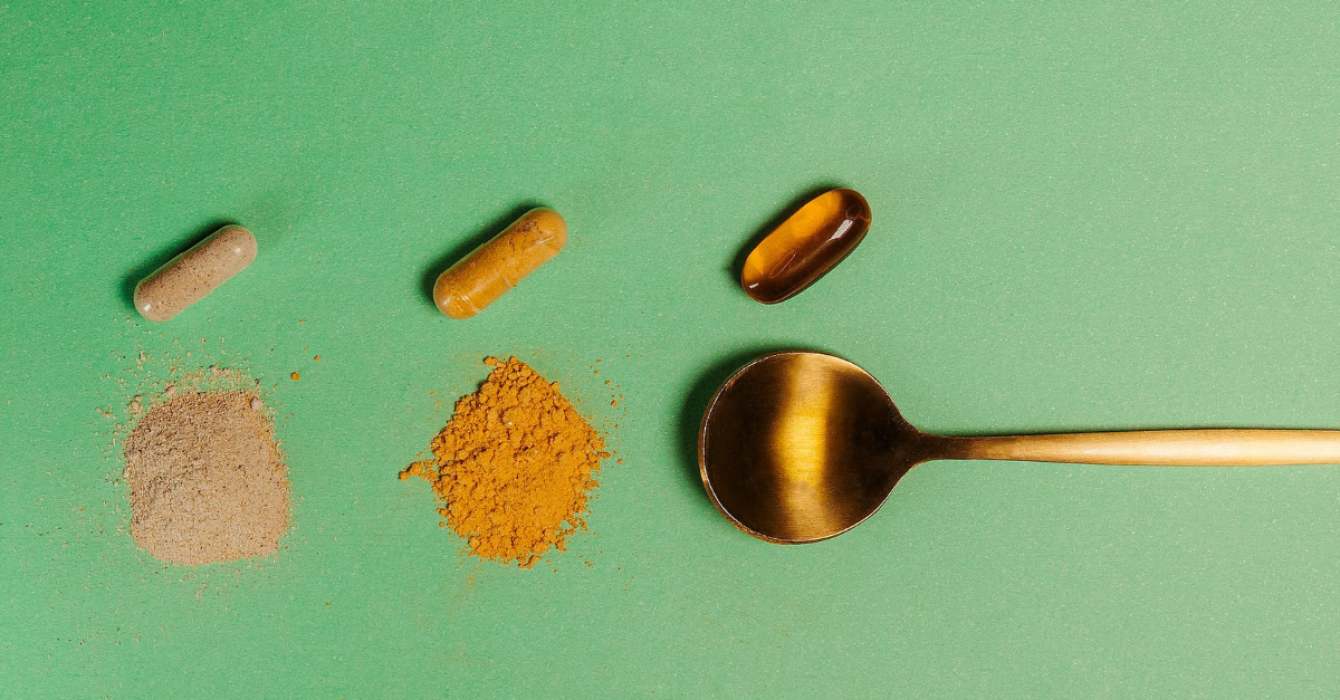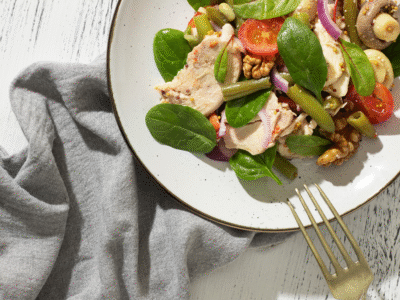Found everywhere from coffee shops to store-bought drinks, adaptogens are all the rage right now —– but how can we start including them in meals at home? Experts weigh in.
Whether propelled by Gwyneth Paltrow’s nootropic morning smoothie or actress Gillian Anderson’s ‘G-Spot’ soft drinks, the adaptogen boom is in full swing.
Contained in everything from ayurvedic plants, holy herbs and berries to bark and fungi, the stress-relieving natural compounds have claimed a spot in modern eating habits once again, having been coveted for their healing and wellness-boosting properties by medical practitioners for thousands of years.
But knowing which options to pick can be daunting, especially with the growing selection on offer. We chatted to founding practitioner of The Forbes Clinic of Integrative Medicine, Dr Anna Forbes, to dispel the confusion and share her advice on how to make adaptogens a safe staple in your everyday diet.

Read more: The best non-alcoholic adaptogen drinks
What are adaptogens and do they really work?
Adaptogens are non-toxic, plant-based substances that can help the body respond to stress, alleviate anxiety, restore balance and support normal metabolic function for better resilience.
“Adaptogens have gained traction in recent years largely due to the increasing prevalence of chronic stress, fatigue and burnout”, explains Dr Forbes. “Modern research is beginning to validate their efficacy in cortisol regulation, mitochondrial support and immune modulation.”
She adds: “In an era where patients are seeking personalised, root-cause approaches, adaptogens offer a bridge between ancient wisdom and emerging science.”
Included in the category are cupboard staples such as turmeric and ginseng, but also licorice root (not to be confused with the black sweets), the trending ashwagandha herb, lion’s mane mushroom and maca root, native to Peru.
Although there’s a growing demand for adaptogens, more research into their effectiveness is needed. Dr Forbes urges people to introduce new supplements gradually and make sure of third-party testing for the highest quality. She says: “Begin with a single agent at a low dose and monitor for shifts in sleep, mood, digestion and energy.”
Due to them being “pharmacologically active”, Dr Forbes also recommends consulting with a trusted medical professional before introducing them to your dietary regimen; extra care is advised for individuals with “autoimmune conditions, hormonal imbalances or psychiatric disorders”, as well as pregnant women.
Read more: From gut health to hormone balance — why women should be adding lion’s mane mushrooms to their essential health kits

Five ways to introduce adaptogens into your diet
-
Shake up your smoothies and teas
Whether it’s pimping your morning cuppa or throwing together what’s left in the fruit bowl, adding adaptogens to your diet through beverages is a convenient and fool proof approach.
Schisandra (a Chinese five-flavour berry), ashwagandha (an ayurvedic herb), maca (a root) and goji berries are all beneficial for brain health — making for the perfect morning kick-starters in smoothies. Dr Forbes recommends ashwagandha in “a golden spiced milk alongside turmeric, cardamom and black pepper” for a restorative energy booster.
For those wanting to avoid the blender (and cleaning thereof), many adaptogens are also available as teas and infusions ready to be brewed. Licorice root is accessible, supports digestion and is sweet to the taste.
We recommend: Pukka’s Peppermint & Licorice tea, buy from Pukka for £4.99.
Read more: Everything you need to know about ashwagandha
-
Sweeten up mushrooms with chocolate
However unlikely this combination might seem, it quite literally works a treat. The earthy richness of functional fungi like reishi or cordyceps — known for their overall health and vitality benefits — blends perfectly with the bittersweet flavour profiles of dark chocolate, which has proven antioxidant effects.
Integrating these medicinal powerhouses into your daily meals — for example, adding mushrooms and chocolate into airy mousses, homemade granola and gooey brownies — can be as simple as whisking in a spoonful of fungi powder or extract into a batter. Dr Forbes pairs reishi with raw cacao in a warm bedtime drink, blended with cinnamon and nutmeg, for a parasympathetic and restful nightcap.
Plus, there’s an endless selection of multi-mushroom blends that allow for maximum functional care.
We recommend: Sevenhills Wholefood’s Organic 7 Mushroom Blend Powder (100g), buy from Amazon for £9.99.
-
Rejuvenate with wellness shots and shrubs
Not to be underestimated, shrubs are fermented fruit syrups mixed with vinegar and are celebrated for their gut- and immune-improving effects. Use organic honey, raw apple cider vinegar, any fruit — or even garlic — and combine with adaptogens like rhodiola (aka golden root), which has been celebrated in Russia and Scandinavia for its claimed fatigue-relieving and memory-boosting properties and can be bought as a supplement or powder.
If you’d rather avoid the addition of refined sugars, wellness shots can be a great solution. Elderberry extract has gained popularity in recent times, and when combined with blueberries and ginger, the result is a supercharged antimicrobial and inflammation-fighting potion.
We recommend: Jaga’s Adaptogenic Wellness Shots, buy from Jaga for £25.
@ottolenghi The Lawnmower – Born from garden sweat and iced tea cravings. Peach shrub + green tea = sharp, cold, wildly refreshing. Ingredients 500g peaches (about 4 or 5), roughly chopped into small pieces, stones reserved 125g light brown sugar 5g thyme sprigs 4 tbsp white wine vinegar 3 green tea bags sparkling wine of your choice (or soda water) and lots of ice fine sea salt Method 1. Add the peaches and their stones, the sugar, thyme and a pinch of salt to a medium saucepan and mix together. Leave to sit for 1 hour, stirring occasionally, until the sugar has all dissolved and a syrup has formed. Add the vinegar and 4 tablespoons of water to the pan, place on a medium-high heat and bring to a boil, then, reduce to simmer and cook for 12 minutes, until the liquid has turned slightly syrupy. Remove from heat and leave to cool to room temp. Discard the peach stones and thyme sprig and place everything in a blender. Blitz until smooth. 2. Meanwhile, pour 500ml of boiling water over the tea bags in a jug, stir and leave to steep until cool, about 30 minutes. Squeeze the bag and discard. The tea and cordial will keep in the fridge for a week, ready to mix when you want. 3. To make the lawnmower, add equal parts of the peach shrub, tea and your chosen bubbles in a jug and mix well. Serve poured over an ice-filled glasses #summerdrink #icedtea #cocktailtok #drinksoftiktok #homebartender #shrubcocktail #gardenlife #refreshingdrinks #Ottolenghi #OttolenghiTestKitchen #OTK #Ottolenghirecipes #Ottolenghisummerfeasting ♬ original sound – Ottolenghi
Read more: What are wellness shots? Everything you need to know
-
Fortify your favourite nut butters and spreads
Granted, not everyone wants to make peanut butter from scratch, but should the stars align, it’s worth adding some adaptogens into the mix to create a super spread that feels as good as it tastes. Popular options include maca root and lion’s mane mushroom, but chaga, another functional fungus known to lower cholesterol, is a great alternative.
For those not wanting to break the bank, turmeric is another impactful adaptogen that can be easily sourced and mixed into a jar of nut spread. Enjoy on toast, in porridge or smoothie bowls, or straight off the spoon as a snack.
We recommend: aum alchemy’s Adaptogenic Peanut Butter series, buy from aum alchemy for £12.
-
Soups, broths and more
A tried and tested method is to cook down adaptogens in anything from mineral-rich bone broth to minestrone, which can simultaneously help mask their at-times aromatic to bitter flavours and is a perfect method for slow extraction.
While there’s a plethora of supermarket produce that can be used, such as shiitake mushrooms and ginseng, the anti-inflammatory and calming holy basil, or tulsi, is a personal favourite of Dr Forbes, and creates a natural wellness potion that packs a punch. With it’s “slightly peppery profile”, holy basil is perfect for Asian coconut-based curries and stir-fries.
We recommend: Buy Wholefood’s Online’s Organic Holy Basil Powder (250g), buy from Whole Foods for £7.95.
Feature image: Pexels
Words: Lena Müller













